- Get link
- X
- Other Apps
- Get link
- X
- Other Apps
Editors note: Unwanted advertising popups are now the default on Google Blogger. The Boresight highly recommends installing free Adblock Plus into your browser to suppress this annoyance - and view our content in peace.
As of March 2024, this warning from the Royal United Services Institute (RUSI) for Defense and Security Studies - has indeed materialized.
Russian Air Force attack aviation has been pounding Ukrainian defenders with a myriad of new heavy high-yield precision glide munitions with devastating effect - that simply obliterate Ukrainian defensive elements. The result of this - is all too predictable. Russian ground forces have now been advancing on nearly all fronts since mid-February 2024.
During this period Ukraine claims to have downed dozens of Russian attack jets and even A-50 AWACS aircraft. However, no clear evidence has materialized to substantiate or corroborate these claims. Perhaps 2 or 3 aircraft have been lost and Russian friendly fire is the likely culprit.
In a related development, we learn back in April 2023 that the Russians have been jamming US-supplied GPS-guided munitions [HIMARS]. Something that should not have come as a surprise.
"The fighter force on the other hand actually been very effective at the moment.""They're being highly, highly effective at inflicting losses on Ukrainian ground attack sorties..." "They are able to threaten and regularly shoot down Ukrainian ground attack sorties from far, far outside the range of any Ukrainian retaliation." - Justin Bronk Ph.D., (Nov 2022) Senior Research Fellow for Airpower and Military Technology at RUSI, London.
In early November of 2022, the Royal United Services Institute (RUSI) for Defence and Security Studies out of the United Kingdom, issued an extraordinary and ominous report about the current and future influence of Russian Air Power in the Russo-Ukrainian War. The study warns the VKS (Russian Air Force) could become a major factor in the ground war henceforth unseen to date. With the outcome being the same as in Syria. After 2015 the VKS would break the back of anti-Assad forces in Syria with a relentless aerial bombing campaign. The thrust of the report here - please see video:
According to RUSI, Russian MiG-31BM (NATO: 'Foxhound') and Su-35S (NATO: 'Flanker') fighters are regularly downing UkrAF (Ukrainian Air Force) aircraft at ultra-long ranges - even if the Ukrainian aircraft fly in clutter and ultra-low altitudes. The Russian fighters are using an all-new (never before seen) ultra-long-range R-37M (NATO: AA-13 'Axehead') and also a new extended-range version of the R-77-1 (NATO AA-12B 'Adder') air-to-air missiles. R-37M range is almost 400 km (215 nautical miles). The new R-77-1 has a range of ~ 110 km (59 nautical miles) Both these Russian fighters also have powerful radars that can look down and shoot down targets maneuvering at treetop altitudes in clutter - from great distances.
The Su-35S 'Flanker-E' loadout is clearly visible here for air superiority CAP over Ukraine. Two ultra-long range R-37M missiles down the aircraft centerline, two R-77-1 extended-range medium-range missiles on the nacelles, one Kh-31PD anti-radiation missile round on the inboard port wing station, and two R-73L/K dogfight missiles on outer stations. Two Khibiny-U ECM pods are also fitted with an 18-LSM1 on the port, and 518-PSM on the starboard wingtips, respectively.
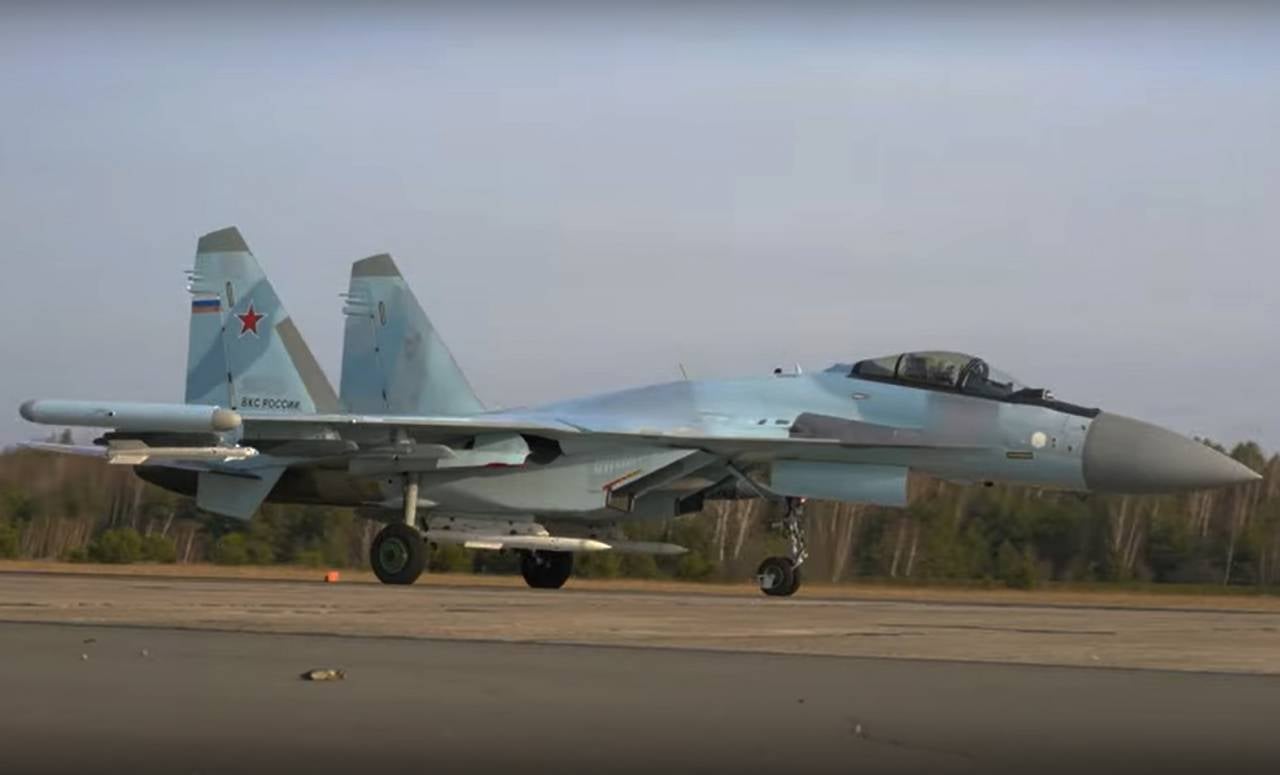 |
| [Above] Su-35S of the VKS operating against the UkrAF with two R-77-1 extended range AA-12B 'Adder' and two R-74M dogfight missile rounds. Aircraft ID markings have been blurred by censors. |
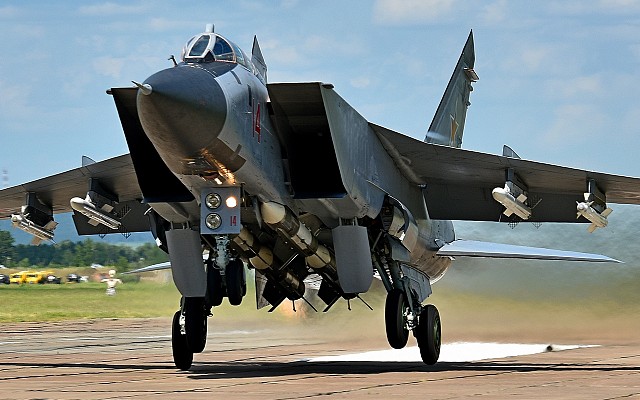 |
| This MiG-31BM Foxhound with 4x R-33 (AA-9 Amos), 2x R-77-1, and 2x R-73L missiles. R-33S range is ~ 160km (86 nautical miles). The MiG-31 also features an upgraded Zaslon-M/AM radar. |
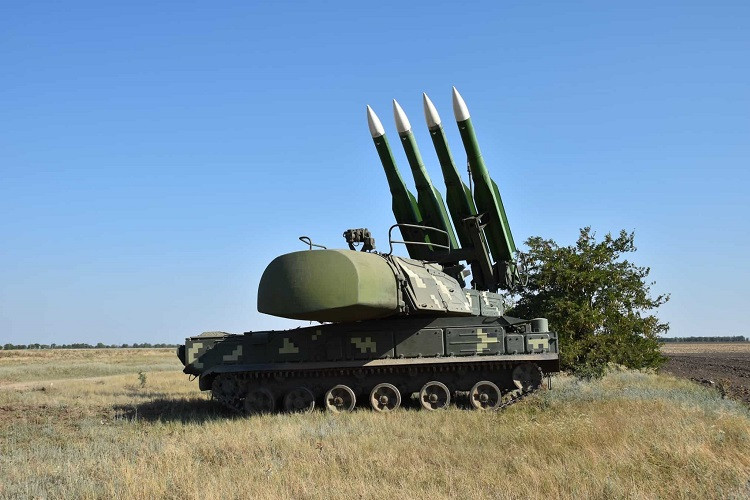 |
| SA-11 'Buk' quadruple launcher. Can hit targets over 80,000 ft (over 24,000 m). |
"Russian air power is largely neutralized from a strike perspective. It's a threat in being rather than major threat a day to day. Because Russia still hasn't managed to effectively hunt down and kill enough of Ukraine's mobile medium and short-range SA-11 and SA-8 SAM systems. And so they're limited to very low altitude attacks essentially beyond the front lines which are then at great risk from MANPADs and even anti-aircraft fire."
"The fighter force on the other hand is actually been very effective at the moment. So what they've done is divided Ukraine (the contact areas in Ukraine) into eight different sectors and they have a pair of fighters on combat air patrol (CAP) in each one during daylight hours. The Russian Air Force is flying about 140 to 160 sorties a day."
"They're being highly, highly effective at inflicting losses on Ukrainian ground attack sorties which are attempting loft rocket attacks, the same as the Russian Su-25s, as well as occasionally bombing attacks with Su-24s on Russian positions because the Russian fighters have both the R-77-1 (AA-12B) but also they're using a lot of R-37s now, a very, very long range air to air missile from both MiG-31B and have been integrating it onto their Su-35S. And what it means is that with the very powerful radar on both of those platforms, the 'Irbis-E' (Su-35) and the 'Zaslon' (MiG-31) that can look down and shoot down very effectively from long range against targets flying in clutter at very low altitudes. They are able to threaten and regularly shoot down Ukrainian ground attack sorties from far, far outside the range of any Ukrainian retaliation."
"If the Ukrainians aren't supplied with additional ammunition from their medium-range SAMs, and ultimately replacement systems to start phasing in Western suppliable, re-suppliable equivalents, things like NASAMS then ultimately the VKS, the Russian Air Force could start to become a major factor on the battlefield in a way it just hasn't up to this point in the war."
"The reason it hasn't is because those surface-to-air missile systems continue to pose a prohibitive threat to Russian sorties at medium and high altitudes inside Ukrainian lines. If those SAMs are no longer able to fire, those sorties will come back in again and we could see a lot of heavy firepower coming in from the air on Ukrainian army positions but also on cities, on towns, on infrastructure, near the front lines."
- Justin Bronk (RUSI) November 8, 2022
[Above] OSINT from September 2022 of Su-35S and Su-30SM3 launch and recovery while conducting CAP (combat air patrol) against the UkrAF in Ukraine. All aircraft can be seen with Khibiny-U wing-tip ECM pods, R-73L 'Archer' dogfight missiles, R-77-1 'Adder-B' extended-range medium-range air-to-air missiles, and at least one Kh-31PD 'Krypton' anti-radiation weapon fitted. Kh-31PD's published range is 160 mi (257 km / 139 nautical miles). No R-37M missiles are seen in these images. No auxiliary drop tanks (ubiquitous for Western fighters) are used or needed by the Flanker fighter series - though they can be fitted. Su-35S and Su-30SM scored many victories against UkrAF early in the war. UkrAF fighters were completely outclassed and overmatched by 'N011M Bars' and 'N035 Irbis-E' radars found in the Su-30SM and Su-35S respectively.
[Above] Equipped with the 'N011M Bars' radar the Su-30SM is able to attack and shoot down UkrAF aircraft at long ranges using the R-77-1 extended-range medium-range ARH missile. Editors note: Since our original writing in 2022, the Naval Su-30SM has also been photographed equipped with the R-37M Axehead.
|
 |
| [Above] R-37M during development tests. The published range is 150–398 km (80-214 nautical miles. [Below] R-37M is an unwelcome development for US-NATO AWACS and air-tanker crews. |
 |
| MBDA-Meteor Range ~ 200 km (110 nmi). [Below] Hughes AIM-54 Phoenix. Range ~ 212 km (114 nmi) |
Editors note: in July 2024 the US Navy announced it had fielded an air-launched version of its RIM-174 Standard SM-6 designated 'AIM-174B.' It may have a range similar to R-37M but AIM-174B weighs in at a hefty ~ 1760 lbs (800 kg) versus ~ 1,120 lb (510 kg) for Axehead. The AIM-174B weapon-release speeds are surely lower than the Russian R-37M, as the Russian weapon is based on the R-33 and was designed to be semi-recessed on the MiG-31, whereas the AIM-174B hangs from USN Hornet wing-pylon. The American weapon has never been used in combat, unlike Axehead.
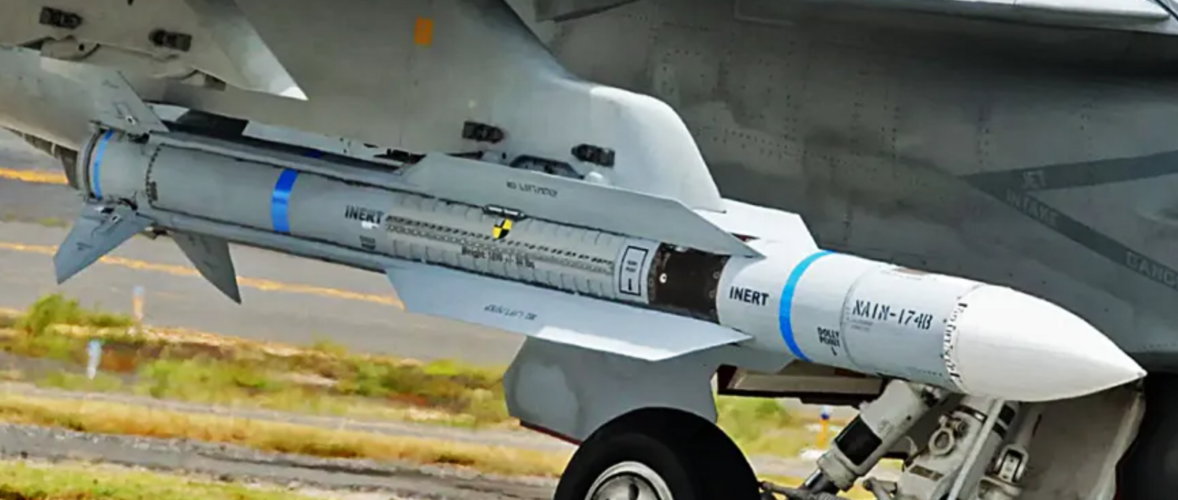 |
| [Above] US-Navy AIM-174B on F-18 Superhornet. We think underwing carriage should limit launch speeds to < Mach 1 thus giving the R-37M and the American weapon similar range performance. |
The development and fielding of powerful aircraft like the Su-35 and MiG-31 derivatives with R-37M capabilities are (as we predicted in 2014) unwelcome news for US-NATO air-breathing AWACS, ISR platforms, and air-tanker fleets.
[Above] Both of these high-value assets (tankers and AWACS) are the cornerstones of the US-NATO power projection doctrine. Su-35S, Su-30SM, MiG-31BM, R-37M, and R-77-1 combat performance against the UKrAF simply underscore what we at the Boresight have always argued. The RUSI publication simply supports our assessment that these key NATO assets can be put at great risk in the air (and on the ground) and would therefore be unable to affect the battle. MIM-104 batteries will need to be mindful of 'Krypton' anti-radiation weapons. Kh-31PD published ranges are ~ 160 mi / 257 km / 139 nautical miles.
[Above/Below] The Russian equivalent to the AGM-88 HARM. The 'Krypton' Kh-31PD anti-radiation weapon.Editors Note: Although not addressed in the published RUSI report, according to Justin Bronk (see video below) when the Russian GBAD crews finally get dialed in after the first few weeks and manually opened their Doppler gates (switched their systems out of automatic mode) they could then see and kill the slow-moving Bayraktar drones, and TB2 fleet began taking heavy losses. This effectively ended the Bayraktar TB2 kinetic combat career in Ukraine. Bayraktar TB2 class drones can only be employed against poorly trained GBAD crews. What we are seeing is the obsolescence of an entire class of weapons, like piston-engined heavy bombers during the Korean War.
 |
| Indeed we predicted Bayraktar TB2 class UAVs (including MQ-1 Predator and MQ-9 Reaper) to be quickly deemed 'not combat effective' (read: obsolete) in Ukraine against modern GBAD manned by properly trained crews. This is precisely what has occurred. To date, at least 14 Bayraktars have been verified destroyed. The life expectancy of any UAV in Ukraine is about 7 days. These classes of drones are an easy target - and therefore certainly are not, (not) the future of air power. We are witnessing the obsolescence of an entire class of weapon platforms, like the piston-engine heavy bomber in the Korean War. |
MANPADS effectiveness in Ukraine is consistent with the historical performance of these systems. When the targeted aircraft uses expendable countermeasures (read: chaff/flare decoys) they typically defeat MANPADS attack(s). Aircraft are downed either when countermeasures are not employed, or because repeated exposure to man-portable attack has exhausted the target aircraft complement of expendables during the sortie.
The complete report originally published by Dr. Justin Bronk, Nick Reynolds, and Dr. Jack Watling
7 November 2022; Title 'The Russian Air War and Ukrainian Requirements for Air Defence'
Other findings detailed by the RUSI report:
- Russian Aerospace Forces (VKS) conducted significantly more extensive fixed-wing strike operations during the first days of the invasion than has been previously documented, while Ukrainian ground-based air defence (GBAD) capabilities were suppressed by initial attacks.
- During this period, Ukrainian fighter aircraft inflicted some losses on VKS aircraft but also took serious casualties due to being totally technologically outmatched and badly outnumbered.
- Russian fighters have remained highly effective and lethal against Ukrainian aircraft near the frontlines throughout the war, especially the Su-35S with the R-77-1 long-range missile and, in recent months, the Mig-31BM with the R-37 very long-range missile.
- From early March, the VKS lost the ability to operate in Ukrainian-controlled airspace except at very low altitudes due to its inability to reliably suppress or destroy increasingly effective, well-dispersed, and mobile Ukrainian surface-to-air missile (SAM) systems.
- Russian GBAD has also been highly effective since March, especially the long-range S-400 SAM system supported by the 48Ya6 ‘Podlet-K1’ all-altitude long-range surveillance radar system.
- Numerous MANPADS provided to Ukrainian troops and later mobile air-defense teams meant that low-altitude Russian fixed-wing and rotary penetrating sorties beyond the frontlines proved to be prohibitively costly during March, and ceased by April 2022.
- Throughout the war, most Russian airstrikes have been against pre-designated targets with unguided bombs and rockets. The Su-34 fleet has regularly also fired stand-off missiles such as the Kh-29 and Kh-59 against fixed targets, and Su-30SM and Su-35S fighters have regularly fired Kh-31P and Kh-58 anti-radiation missiles to suppress and target Ukrainian SAM radars.
- Without air superiority, Russia’s attempts at strategic air attack have been limited to expensive cruise and ballistic missile barrages at a much more limited scale. These failed to achieve strategically decisive damage during the first seven months of the invasion. However, the latest iteration is a more focused and sustainable bombardment of the Ukrainian electricity grid, blending hundreds of cheap Iranian-supplied Shahed-136 loitering munitions against substations with continued use of cruise and ballistic missiles against larger targets.
- The West must avoid complacency about the need to urgently bolster Ukrainian air-defence capacity. It is purely thanks to its failure to destroy Ukraine’s mobile SAM systems that Russia remains unable to effectively employ the potentially heavy and efficient aerial firepower of its fixed-wing bomber and multi-role fighter fleets to bombard Ukrainian strategic targets and frontline positions from medium altitude, as it did in Syria.
- It follows that if Ukrainian SAMs are not resupplied with ammunition, and ultimately augmented and replaced with Western equivalents over time, the VKS will regain the ability to pose a major threat.
- In the short term, Ukraine also needs large numbers of additional man-portable air-defense systems (MANPADS) and radar-guided anti-aircraft guns, such as the Gepard, to sustain and increase its ability to intercept the Shahed-136s and protect its remaining power infrastructure and repairs to damaged facilities.
- In the medium term, Ukraine needs cost-effective ways to defend itself against the Shahed-136. One option could be compact radar and/or laser ranging and sighting systems to allow numerous existing anti-aircraft guns to be much more accurate and effective against them.
- The Ukrainian Air Force fighter force needs modern Western fighters and missiles to sustainably counter the VKS. Russian pilots have been cautious throughout the war, so even a small number of Western fighters could have a major deterrent effect.
- Any Western fighter supplied in the short–medium term needs to be capable of dispersed operations using mobile maintenance equipment and small support teams, and flying from relatively rough runways, to avoid being neutralised by Russian long-range missile strikes.
Observations not addressed in the report directly:
- IFF (Identification Friend or Foe) environment must be classified by definition in Ukraine - as extreme. This includes IFF transponder interrogation, NCTR, and Mk1 eyeball. This is because both belligerents use effectively identical kit. We hypothesize problems likely were extreme and persisted - especially during VKS manned deep strikes at low altitudes. It is highly plausible both belligerents were falling victim to fratricide/friendly fire from both their own fighter combat air patrol, MANPAD, and GBAD. Based on what we saw in Georgia in 2008 perhaps 50 percent of VKS losses in Ukraine at low altitudes may be due to fratricide/friendly fire from Russian fighter CAPs. Only an investigation after the war can support this hypothesis. The report does not attempt to apprise Russian NCTR.
- Kyiv claimed they were able to degrade VKS A-50 AWACS performance but this could also be due to Russian own EW. Russian own EW almost surely interfered with Russian own radio comm especially early in the war.
- Whatever Western-based GBAD supplied to Kyiv can still be attacked by Russian anti-radiation and/or depleted by drones. Any radar-based system can be attacked by anti-radiation weapons.
- The report omits Ukrianeian Bayraktar TB2 ops - which have gone completely extinct since the beginning of the war. The TB2 was simply no match for modern Russian fighters and GBAD manned by properly trained crews. Slow flight speed was the key. Something we predicted would occur. Videos of TB2 ops were slowly fed to OSINT long after their TB2 fleet had been sidelined.
- The success of the Russian air superiority fighters in Ukraine means that these aircraft, radar, and missile programs were indeed developed/funded/fielded; in sharp contracts to popular Western assertions that the Russian military has been gutted for decades by the current Russian presidency. The fielding of the systems means there was no cogent basis for these Western recriminations.
- "Neither side has been able to find an effective answer to cheap and plentiful quad-copter drones. They linger over both belligerent troops who remain completely oblivious to their presence."
- Kyiv GBAD is almost surely using avoiding Russian SEAD the same way the Serbs did against NATO in 1999. GBAD is switched on for short periods and then switched off again.
- The report overstates the threat by AGM-88 HARM to Russian GBAD. Russian AD systems are mobile just as Keiv systems are.
- Will Russia continue to allow US-NATO ISR assets orbiting in the region to supply Kyiv with intelligence or use EW or other methods to degrade these platforms?
 |
| Ilyushin-Beriev A-50U (NATO: Mainstay) at Vorkuta Sovetsky Air Base July 2015. Photo Vladimir Ivanov |
Works Cited
“Breaking of the World: New Phase Russo-Ukrainian War: Syria Playbook.” Breaking of the World, https://theboresight.blogspot.com/2022/10/breaking-of-world-new-phase-russo.html. Accessed 13 Nov. 2022.
Combat Sorties by Su-35S and Su-30SM Fighter Crews. www.youtube.com https://www.youtube.com/watch?v=K3yUbJtbXnw. Accessed 13 Nov. 2022.
Carroll, W. (2022). The REAL truth about the Air War over Ukraine [Video]. In YouTube. https://youtu.be/YYDnspMWdaM
R-37 Long-Range Aircraft Missile (RVV-BD) | Missilery.Info. https://en.missilery.info/missile/r37. Accessed 13 Nov. 2022.
R-77-1 Medium-Range Aviation Missile (RVV-SD Product 170-1) | Missilery.Info. https://en.missilery.info/missile/rvv-cd. Accessed 13 Nov. 2022.
Short Range Airborne Missile RVV-MD | Missilery.Info. https://en.missilery.info/missile/rvv-md. Accessed 13 Nov. 2022.
“The Russian Air War and Ukrainian Requirements for Air Defence.” Royal United Services Institutemenuplussearchsearchclockpdfprintfacebooktwitterlinkedinemailprintfacebooktwitteryoutubelinkedinrss, 7 Nov. 2022, https://rusi.org/explore-our-research/publications/special-resources/russian-air-war-and-ukrainian-requirements-air-defence.
“Vympel R-77.” Weaponsystems.Net, https://weaponsystems.net/system/665-Vympel+R-77. Accessed 13 Nov. 2022.
“Warning Russian Air Force Could Become ‘major Factor’ in Ukraine War.” Forces Network, https://www.forces.net/technology/aircraft/western-support-needed-combat-russias-new-approach-air-war-ukraine. Accessed 13 Nov. 2022.
Combat sorties of Su-30SM and Su-35S aircraft of the Russian Aerospace Forces. 2022. rutube.ru, https://rutube.ru/video/639a5a1c0c0981712e38bb769f0ac26f/.
Yulia Kulikova. “Russian Su-35S and Su-3SM crews destroyed Ukrainian aircraft.” Izvestia, 1 Nov. 2022, https://iz.ru/1419024/2022-11-01/rossiiskie-ekipazhi-su-35s-i-su-3sm-unichtozhili-ukrainskii-samolet.
- All media found here is for scholarly and research purposes and protected under U.S. Internet Fair Use Law -
Comments




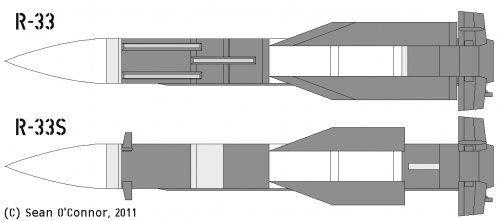







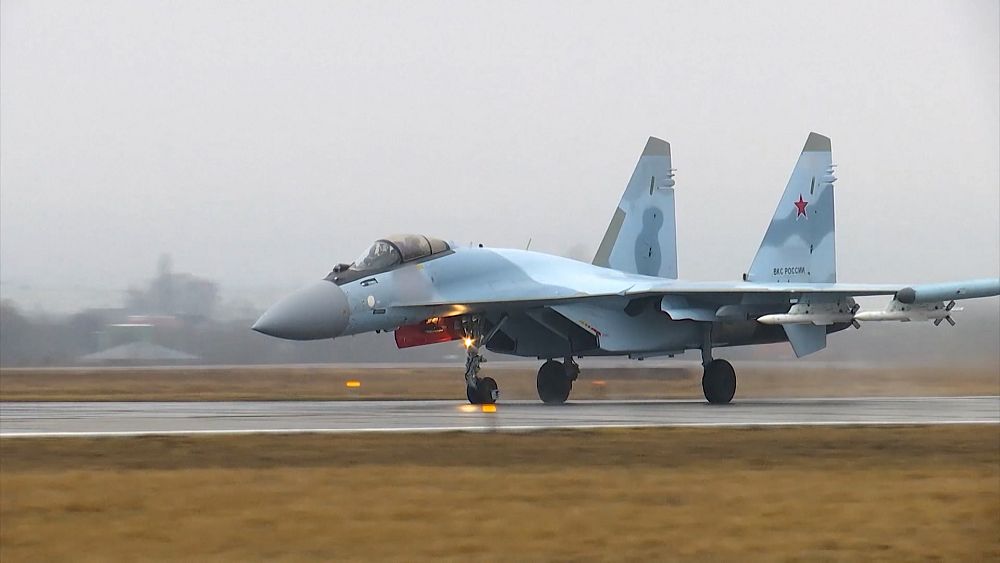
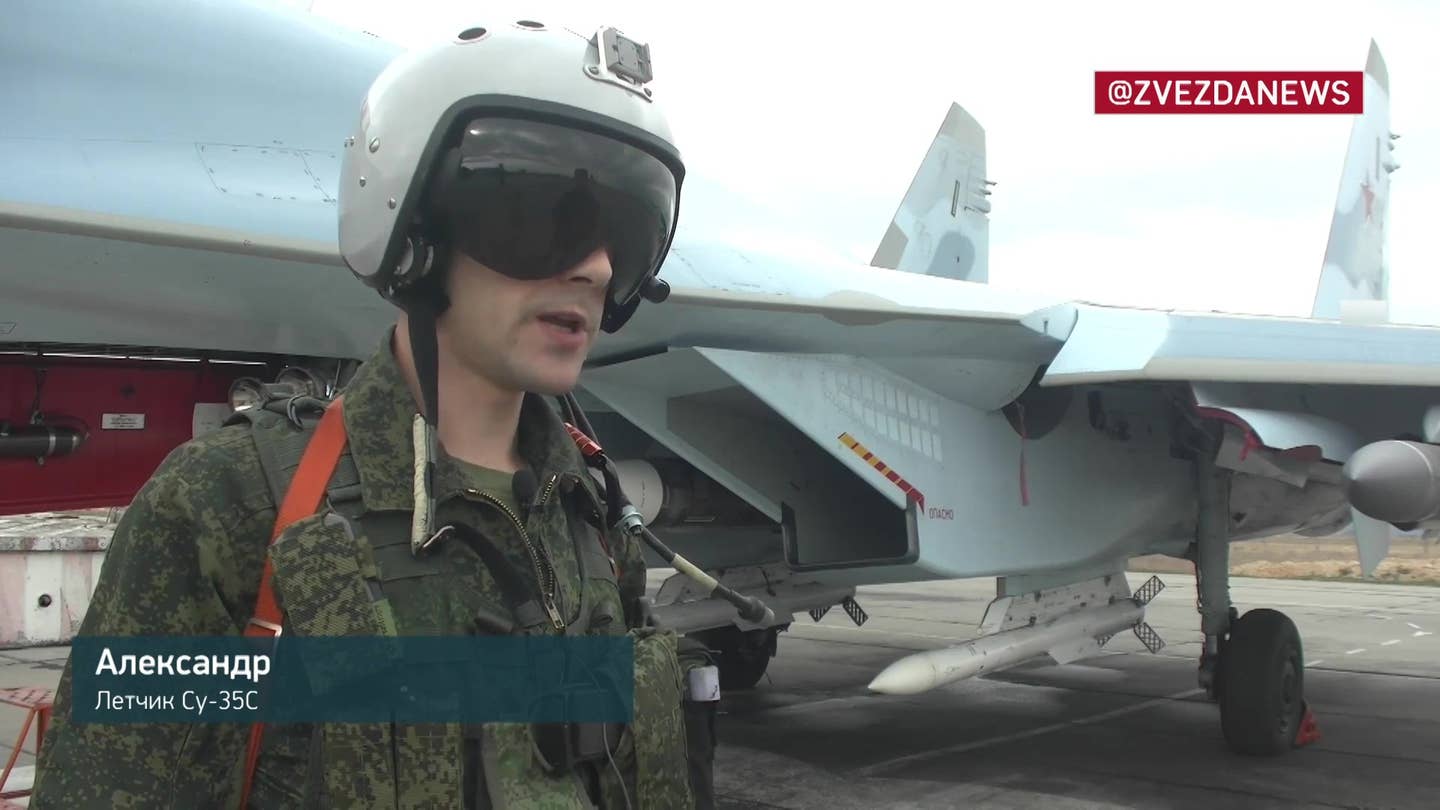



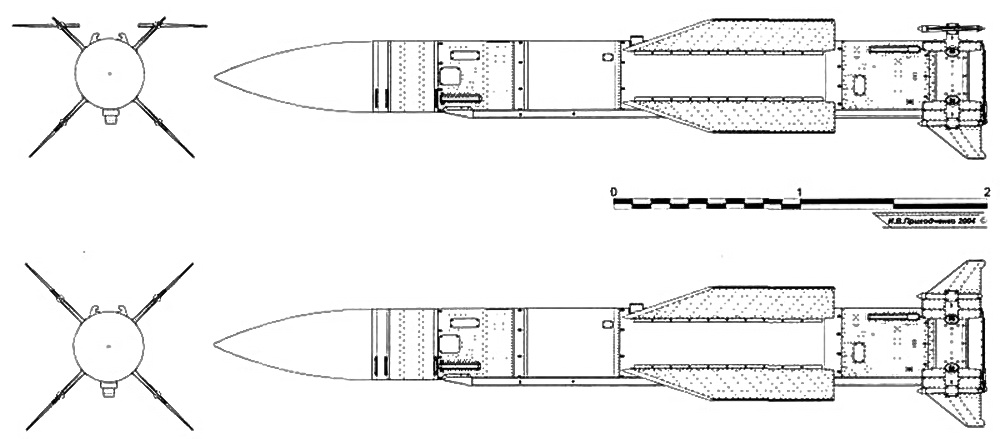




I feel like it is too strong a word to say Russia has 'air superiority' if they cannot sufficiently penetrate Ukrainian airspace or dismantle it's IADS.
ReplyDeleteRussian anti-radiation missiles must be used alongside SEAD and DEAD tactics with highly trained pilots in sustained operations, I'm not convinced Russia has the logistical capacity to maintain SEAD operations to dismantle Ukrainian IADS. Especially not if the west actively replenishes that IADS.
Flood the zone with cheap drones and force Ukrainian AD to switch on their radars - otherwise all drones get through to their targets. When they do turn on their AD radars - you fire your anti-radiation weapons at them. The UK-based RUSI would not be issuing a warning if Ukrainian AD were not headed for exhaustion and/or collapse. All the great predictions in the West that the Russian could not develop nor fund weapons like R-77-1 and R-37M - was all complete BS.
DeleteWhat If the Ukrainian AD shoots and scoots, rapidly redeploying?
DeleteAnd can the Russians co-ordinate a large scale air operation? Can they get into position? Can Ukrainian fighters disrupt this campaign. I feel like this is far more complicated than you claim, otherwise Russia would have done this initially when they launched their cruise missile strikes.
Russia wouldn't be able to destroy all SAM sites simultaneously, they would only be able to threaten the SAM sites within range of their missiles. And with how American AWACS can watch Russian movements with impunity it's likely Ukraine would have the intel to counteract this strategy.
Besides "The UK-based RUSI would not be issuing a warning if Ukrainian AD were not headed for exhaustion and/or collapse." I believe is incorrect. Their warning that eventually Ukrainian AD will be attrited out inevitably, but that this can be prevented by the sending of missiles and weapons systems by the west. Similar to how the Issue of Russian artillery advantages led to the west sending it's own artillery to use longer range to even the score. The same could be true of modernised western AD being able to increase Ukraines current IADS capabilities.
Again. The UK-based RUSI would not be issuing a warning if Ukrainian AD were not headed for exhaustion and/or collapse. So you'd need to take up your questions with them. When (or if) that happened - in will be Syria 2.0. The VKS already has 16 CAP fighters (divided into 8 sections) on station across Ukraine areas of contact. They typically are carry Kh-31P to release. Shoot and scoots works better for artillery. For GBAD you need to turn-on your radar.
DeleteThey already did all this in Syria. The difference is Syria wasn't a Russian ground force operation. So I cant speak to Russian army ground forces.
It looks like Patriots are being sent to Ukraine now, alongside more mobile avenger missile system this could help recoup Ukrainian IADS. This could negate Russia's Attrition strategy.
DeleteLets see if the batteries are placed in Poland or Ukraine(?)
DeleteIt won't affect the Russian strategy because you get the same outcome either way. If the Patriot is used against cheap drone swarms will simply exhaust its ammunition. If they attempt no save Patriot ammunition then the US system have no tactical or strategic effect(s). The system can also be attack with anti-radiation weapons. The real issue is will be manned by US personnel - which is the biggest problem. US military involvement in Ukraine's civil war is perhaps the greatest Washington policy blunder in modern times.
- Boresight
Surovikin seems to have been replaced with Gerasimov, it looks like Russia has lost faith in the strategic bombing campaign?
ReplyDeleteThe Russian have pushed-in south of Bakhmut towards Chasiv Yar. I wouldn't read too much into the reshuffle of Surovikin. He's an air force guy - and VKS fighters MiG-31BM/Su-35S/Su-30SM have indeed established air superiority over of the areas of contact. The Russians may believe now is the time to put Army guy in charge. SEAD is likely remain difficult because both side use nearly identical kit (S-300 / SA-11 / SA-8) so delineating your air defense radars from the bad guys radars - is likely a daunting task. A US-NATO army would have the same problems if your opponent also used the MIM-104. The Russian has no shortage of 'Krypton' anti-radiation weapons however. We shall see what develops.
Delete- Boresight